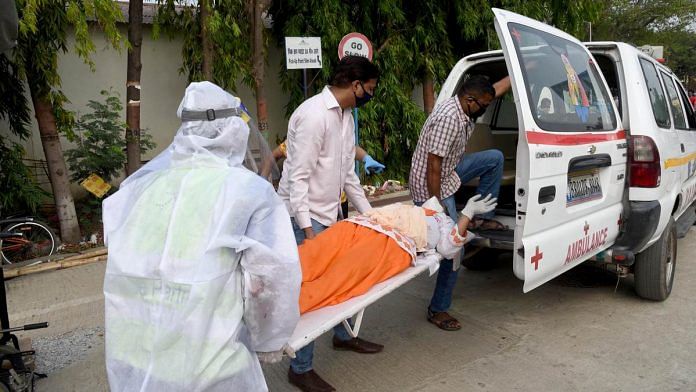New Delhi: The expert panel formed by the central government’s Department of Science and Technology, which had concluded that India crossed its Covid peak in September when there were around 10 lakh active cases, has also estimated that if present measures such as masks, hand hygiene and social distancing are not maintained, India could be headed for a bigger peak around November.
In such a situation, active cases could rise within a month to 25 lakh, and mortality could treble by February. However, the panel has estimated that if all precautions continue to be taken, India could be left with around 20,000 cases by February, top government sources told ThePrint.
India currently has a total of 1,14,610 Covid deaths, with a case fatality rate of 1.52 per cent.
“In its detailed report, the committee has given different scenarios,” a government official told ThePrint. “The best case scenario is 100 per cent adherence to all Covid protocols from now until February, in which case it estimates that the total number of cases would come down to about 20,000 in the country. But in all the other situations, the numbers would naturally go much higher.”
Manindra Agrawal, member of the DST’s committee and Professor of the Department of Computer Science at IIT Kanpur, told ThePrint: “If the existing personal safety protocols do not continue in full measure, we could see another peak in November and it can be even bigger. In fact, we estimate that if these measures do not continue, active cases could rise to 25 lakh within a month (from the current 7,72,055).
“But the biggest impact would then be on mortalities. If all these precautions are thrown to the wind, we can see mortalities easily tripling by February.”
Apart from Agrawal, the committee included Professor M. Vidyasagar of IIT Hyderabad, Dr Gagandeep Kang of CMC Vellore, Professor Biman Bagchi of Indian Institute of Sciences, Bengaluru, professors Arup Bose and Sankar Paul of Indian Statistical Institute, Kolkata, and Lt Gen. Madhuri Kanitkar from the Ministry of Defence. The committee was tasked with arriving at a ‘Covid-19 India National Supermodel’.
Also read: India may have crossed Covid peak, stage set for economic recovery, says finance ministry
‘60-65 infections for every case’
Agrawal explained that the model arrived at by the expert committee is unique — it uses the number of positive tests on a given day to arrive at an estimate of the actual number of infections in the population two weeks ago, since the incubation period of the SARS-CoV-2 virus in the body is a maximum of 14 days.
“Our estimate is that for every person tested positive at the present moment, there are 60-65 untested asymptomatic positives in the population. We have not used the ICMR sero survey data to arrive at this figure. The sero survey is a sort of independent confirmation of our model,” he said.
The ICMR sero survey in August had estimated that for every case, there were 26-32 undetected infections in the population.
The committee will continue its work of estimating the spread of the disease both at the state and national levels. While the state projections are a work in progress, the committee estimated that in Delhi, there would be about 40 undetected asymptomatic positives for every known positive. The current caseload in Delhi is 3,31,017.
These correlations also led the panel to a conclusion that had migrant workers been allowed to go home at the start of the lockdown, the disease would have spread to UP and Bihar.
“Even if the actual cases in the country then were just about 500, we estimate that at the time, because testing was so limited, there would have been about 100 undetected asymptomatic positives in the population for every known positive. Thus, the real number of infections was around 50,000 and not 500 at that point according to our estimate,” Agrawal said.
No estimate of deaths
The model, however, did not make any estimates about whether Covid deaths were missed too, along with cases.
“As I explained, the model looked at positive cases to estimate the spread in the population. However, something like this is not possible for deaths. Also, my own personal assessment is that a large number of deaths could not have been missed in a country like ours,” Agrawal said.
Asked about limitations of their model, he added: “Like all mathematical models, this is an approximation of reality. If you start to estimate actual numbers from this, that is problematic. But if you arrive at a good trend, you should be happy.”
Also read: India’s Covid peak to arrive mid-November, paucity of ICU beds, ventilators likely: Study






